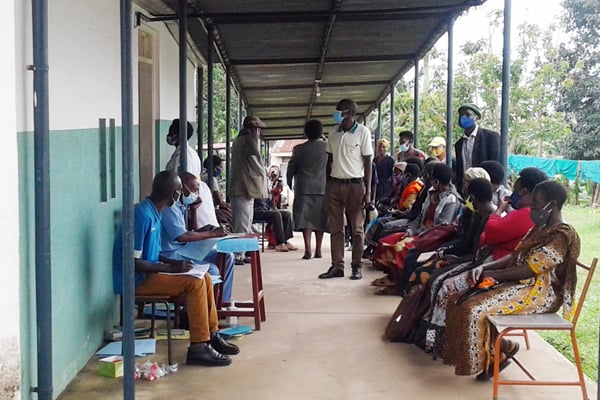High TB cases worry Bushenyi leaders

Patients line up at Grade A hospital at Kitagata in Sheema District to test for TB in March. Leaders in Bushenyi and Sheema districts have decried the rising cases of TB in the area. PHOTO | MILTON BANDIHO
What you need to know:
- According to the World Health Organisation (WHO), TB is an infectious disease that most often affects lungs. It is caused by a type of bacteria. It spreads through the air when an infected person coughs, sneezes or spits.
Leaders in Bushenyi and Sheema districts are worried over the high numbers of Tuberculosis (TB) cases reported in the district.
According to the World Health Organisation (WHO), TB is an infectious disease that most often affects lungs. It is caused by a type of bacteria. It spreads through the air when an infected person coughs, sneezes or spits.
The Bushenyi District Health Officer, Dr Edward Mwesigye, said when Covid-19 was declared a pandemic, people focused on preventing its (Covid-19) spread and lessened the fight against other diseases, including TB.
Dr Mwesigye said TB is one of the serious killer diseases across the globe which must be prevented by not only health workers but rather the whole community.
“In Bushenyi alone, 34 people have been diagnosed with TB in the last 12 months and most of these cases are reported in Kizinda-Kigoma Town Council, Kyamuhunga, Kakanju and Nyabubare sub-counties, and Central Division. People have paid more attention to Covid-19, giving room to other diseases,” he said during a stakeholders’ engagement meeting on advocacy and implementation on TB and leprosy in Bushenyi-Ishaka Municipality last Friday.
Dr Raymond Byaruhanga, the TB coordinator at the Ministry of Health, said the TB death toll has increased in recent years across the country.
He said 5,000 deaths were registered in 2022, which showed an increase from 3,100 cases registered in 2021.
“When you look at the trend, Kazo District tops the chart and has the most affected people, and Uganda as a country is among the most affected countries in the world,” he said.
Dr Byaruhanga attributed the cause of death to stigma among patients battling TB and failure to access medical service at the early stages of the disease.
“The Ministry of Health, together with other partners, has now embarked on a strategy to end T and leprosy by 2030, and we want everyone on board, especially our leaders because if we are to make this a reality, we must join hands,” he said.
Ms Jemmimah Buhanda, the Sheema District chairperson, said they are willing to join the struggle in the fight against TB, but the Ministry of Health must draw a clear programme to be followed.
“In Sheema District, the sub-counties of Kitagata and Kashekuro are the most affected and this is partly because Kitagata hospital receives more TB patients daily from other districts,” she said.
Dr Byaruhanga said Uganda is among the 22 countries with a high burden of T concentration in the world at 80 percent. Since 1995, the case notification rate has been increasing every year by 10 percent and over the years, Uganda launched mass vaccination against tuberculosis.
About TB
According to WHO, TB is the 13th leading cause of death and the second leading infectious killer disease after Covid-19. At least 1.6 million people died from TB in 2021.
In 2021, an estimated 10.6 million people, including six million men, 3.4 million women and 1.2 million children fell ill with TB worldwide. TB is present in all countries and age groups.
TB is curable and preventable. An estimated 74 million lives were saved through TB diagnosis and treatment between 2000 and 2021.
WHO explains that TB infection and spread can be prevented by seeking medical attention if you have symptoms like prolonged cough, fever and unexplained weight loss as early treatment for TB can help stop the spread of disease and improve your chances of recovery.
One should get tested for TB infection if you are at increased risk, for instance if one is living with HIV/Aids or are in contact with TB patients. If prescribed treatment to prevent TB, one should complete the full course. If you have TB, practice good hygiene when coughing, including avoiding contact with other people and wearing a mask, covering your mouth and nose when coughing or sneezing, and disposing of sputum and used tissues properly.




